Mastering the Powerslide: Technique and Impact
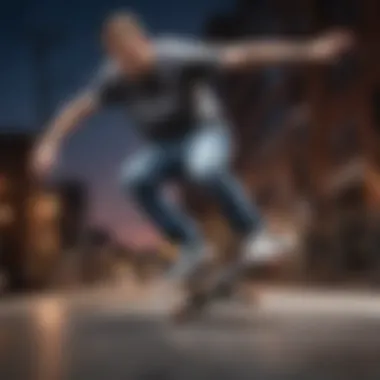
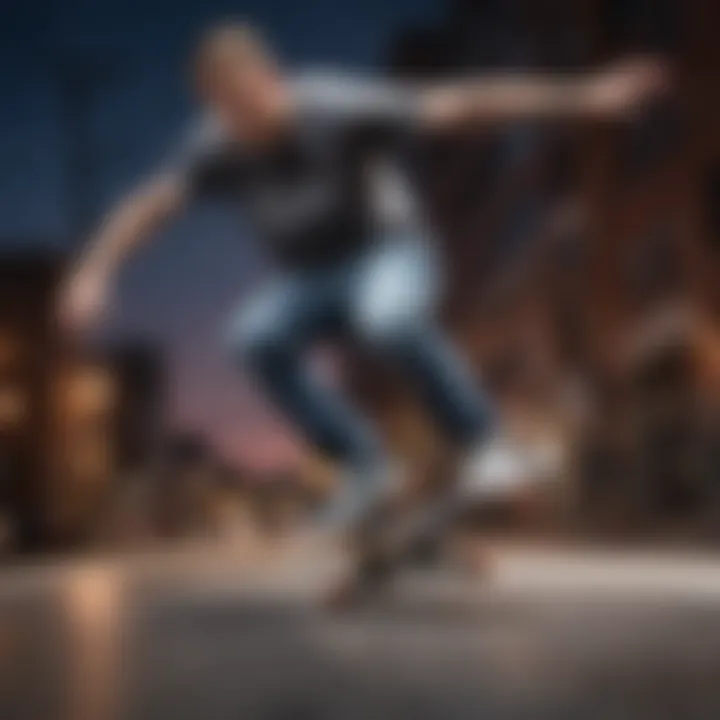
Intro
In recent years, skateboarding has transcended beyond a mere fringe activity to become a prominent fixture in extreme sports. Among the various techniques that define a skateboarder's skill set, the powerslide emerges as a pivotal maneuver. This technique not only showcases control and precision but also highlights a skateboarder’s ability to navigate various terrains effectively. The powerslide is fundamental for both practical reasons, such as stopping quickly, and aesthetic purposes, adding flair to a performance.
This article aims to dissect the powerslide's mechanics and applications, providing insights that cater to both novices and seasoned skateboarders. We will also examine the broader context in which this technique exists, such as its role in enhancing performance and shaping skate culture. By understanding the intricacies of the powerslide, readers will gain practical knowledge that can significantly elevate their skating experience.
Extreme Sports Overview
Definition of Extreme Sports
Extreme sports refer to activities that involve a high degree of risk and adrenaline. They encompass disciplines that push human limits, combining athleticism with elements of danger. Skateboarding stands out within this realm due to its creative potentials and technical demands.
History and Evolution
Skateboarding originated in the late 1940s, with surfers in California seeking ways to practice their moves on dry land. Early designs were rudimentary, but as the sport evolved, so did the equipment and techniques. By the 1970s, skateparks began to emerge, enabling skateboarders to explore diverse tricks and styles. The advent of vert ramps and street skating further pushed the boundaries of what was possible on a skateboard.
Popular Extreme Sports Disciplines
In addition to skateboarding, other notable extreme sports include:
- Snowboarding
- Bungee jumping
- BASE jumping
- Rock climbing
Each of these disciplines shares a common thread of seeking thrills and overcoming challenges.
Gear and Equipment
Essential Gear for Different Sports
For skateboarders, the right equipment is crucial for both safety and performance. Key items include:
- Skateboard: Choosing the right board affects trick execution.
- Helmet: Essential for head protection from falls.
- Pads: Knee and elbow protection can prevent serious injuries.
Gear Reviews and Comparisons
Skateboard brands often release new models that cater to different skating styles. Popular options include the Element Skateboards and Santa Cruz Skateboards. Each has its unique features and benefits, making it essential for skaters to consider their specific needs before purchasing.
Safety Ratings and Certifications
When selecting gear, it is wise to check for safety certifications. Products that meet high safety standards can greatly reduce the risk of injury during practice or performance.
"Skateboard safety gear is not just an accessory; it's an investment in a skater's future performance and well-being."
Training and Preparation
Physical Conditioning and Fitness Tips
Skateboarding, especially techniques like the powerslide, requires good physical conditioning. Exercises that focus on balance, core strength, and flexibility can significantly improve performance. Strength training, particularly for the legs, helps with stability during powerful maneuvers.
Mental Preparation Techniques
Skateboarding is not just a physical activity; it also demands mental resilience. Visualization techniques, where skateboarders imagine executing a powerslide successfully, can enhance focus and confidence. Practicing mindfulness can also help in managing stress before performing.
Training Regimens for Various Sports
To master the powerslide, skaters can incorporate a structured training regimen:
- Warm-up: Always start with stretches to prevent injuries.
- Footwork Drills: Practice sliding on flat surfaces to build confidence.
- Balance Exercises: Engage in activities like yoga or balance boards to enhance stability.
Locations and Destinations
Top Destinations for Extreme Sports
Skateboarding is best enjoyed in places designed for it. Skateparks, urban areas with smooth surfaces, and dedicated skate spots worldwide attract skateboarders from all walks of life. Cities like Los Angeles and Barcelona are renowned for their vibrant skating scenes, featuring numerous parks and cultural sites.
Travel Tips and Guides
For those traveling to skate, it is advisable to research skate-friendly accommodations and local regulations. Many cities have specific laws regarding where you can skate, so being informed helps avoid unnecessary fines. Also, connecting with local skate communities can provide inside tips on the best places to practice and enjoy the sport.
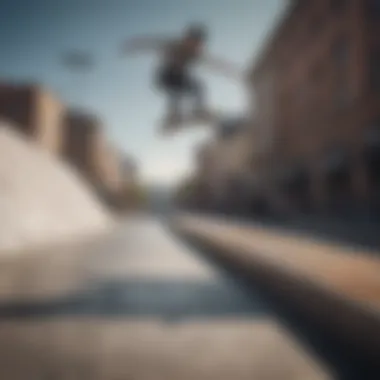
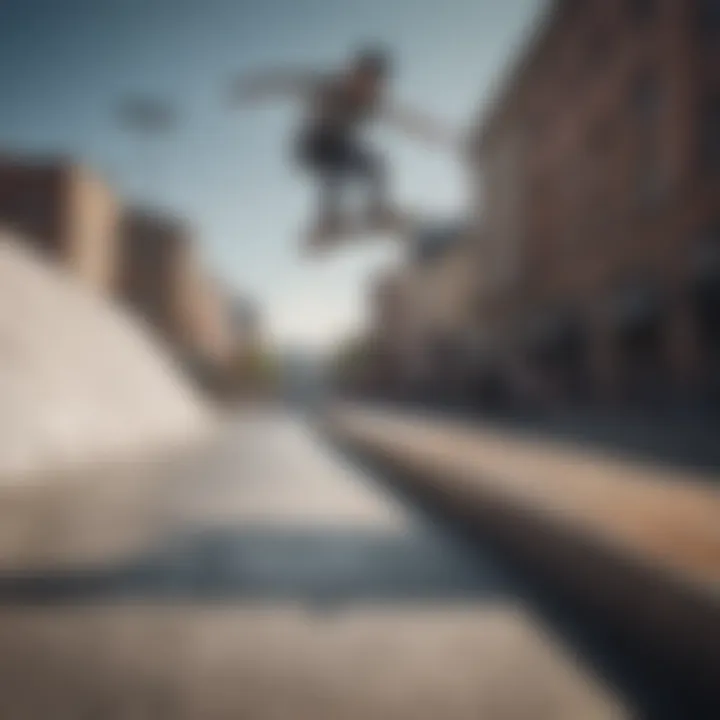
This exploration of the powerslide, its technique, application, and the surrounding culture enhances the understanding of skateboarding thrived in extreme sports. With attention to this fundamental skill, every skateboarder can elevate their game and enrich their experience on the board.
Foreword to the Powerslide
The powerslide is a fundamental yet intricate maneuver in skateboarding that holds significant importance within the sport. It allows skateboarders to control speed and execute sharp turns while maintaining balance and stability. Understanding the powerslide is crucial for all skateboarders, whether they are beginners just starting out or seasoned athletes looking to refine their skills. By mastering this technique, skaters not only enhance their performance but also increase their safety while skating.
This section serves as a gateway to the detailed exploration of the powerslide, offering insights into its definition and historical significance. The following subsections will delve deeper into what defines a powerslide and how it has evolved within the skateboarding culture.
Definition and Overview
In simple terms, a powerslide is a sliding maneuver executed while skateboarding, where the rider intentionally shifts their weight to a specific angle, causing the skateboard's wheels to lose traction with the ground momentarily. This technique provides the skater with a means to slow down quickly without having to use their foot to brake, making it especially useful when navigating tight corners or avoiding obstacles.
Powersliding involves precise body positioning and careful weight distribution. The ability to perform a powerslide effectively requires practice and a good understanding of physics that governs balance and movement. Skaters can perform variations of the powerslide, each tailored to different styles of skating, whether in street, vert, or downhill environments.
Historical Context
The origins of the powerslide can be traced back to the early days of skateboarding in the 1970s. As skateboarders began to explore more aggressive styles and tricks, the powerslide emerged as a practical solution to manage speed and enhance flow. Iconic skaters such as Tony Hawk and Steve Caballero contributed to popularizing the maneuver, showcasing its versatility in competitions and exhibitions.
Over the decades, the powerslide has evolved, gaining recognition as an essential skill among skateboarders. With the influence of various skateboarding styles and subcultures, new adaptations of the powerslide continue to develop. It now plays a significant role in competitive events, artistic expressions, and overall skateboarding technique.
"The powerslide is more than just a trick; it's a statement of control, demonstrating a skater's understanding of their board and the environment."
In understanding the historical context, skaters can appreciate the depth of the powerslide beyond its technical aspects. This comprehension fosters a connection between the skater and the skateboarding community, encouraging further exploration of techniques that defined the sport.
The Mechanics of a Powerslide
Understanding the mechanics of a powerslide is fundamental for both novice and experienced skateboarders. Mastering this technique allows skaters to navigate various terrains, adjust their speed, and execute tricks with finesse. The mechanics encompass necessary elements including body positioning, weight distribution, and turning techniques. Each component plays a crucial role in successfully performing a powerslide and contributes to the overall safety and effectiveness of the maneuver.
Body Positioning
Body positioning is critical to the success of the powerslide. The skateboarder must maintain a low center of gravity for better stability. This is often achieved by bending the knees and leaning slightly forward. Proper body alignment ensures that the weight is distributed correctly over the skateboard, promoting better control during the slide.
It is recommended to position the shoulders parallel to the skateboard. This alignment aids in directing the board and navigating turns more efficiently. Proper stance will also allow the skater to react quickly to changes in balance, which is essential in maintaining control during the slide. Furthermore, keeping the arms extended slightly can offer additional balance.
A poor body position can lead to loss of control, resulting in falls or injuries.
Weight Distribution
Weight distribution plays a crucial role when it comes to executing a powerslide with precision. It needs to be shifted effectively to initiate and sustain the slide. In the initial approach, the skater should focus on shifting weight toward the back foot before beginning the slide. This weight shift is essential to apply sufficient force against the wheels.
If weight is not balanced correctly, the skateboard may not slide smoothly, leading to abrupt stops or spins. After initiating the slide, the skater should subtly adjust weight between both feet to maintain momentum and control. Failing to manage weight distribution may result in stalling the slide or losing traction altogether.
A common error in weight distribution involves leaning too much to one side, which can affect the angle and duration of the slide.
Turning Techniques
Turning techniques are integral to the execution of a powerslide. A skater should prepare to initiate the turn before beginning the slide. This is often accomplished by turning the front wheels in the desired direction while keeping the back wheels aligned. The angle at which a skater turns can affect the outcome of the powerslide.
A tighter turn requires more momentum and a sharper angle, while a wider turn allows for more stability and control. Proper turning techniques can help in steering clear of obstacles and ensuring safety. For best results, a skater should practice different turning styles to grasp how each influences the slide.
"Powerslides are not just about stopping; they are about controlling your ride through various techniques."
Executing the Powerslide
Executing a powerslide is a crucial component of skateboarding technique. It is not only a visually impressive move, but it also enhances control and stability during rides. Mastering the powerslide allows skateboarders to navigate turns more effectively, reducing speed without loss of balance. This ability is especially pertinent in street and downhill skating where quick maneuvers are often necessary. Understanding the intricacies involved in executing the powerslide can lead to improved overall performance and confidence on the skateboard.
Preparatory Steps
Before attempting the powerslide, specific preparatory steps are essential. First, ensure you are familiar with the basic stance on your skateboard. Position your feet correctly, with your front foot over the front trucks and your back foot near the tail. It is vital to feel balanced and comfortable in this stance.
Next, practice rolling at a comfortable speed. Too much speed can complicate the process, while too little won't provide the necessary momentum for the slide. Gradually accelerate to find your optimal speed. Consider checking your environment as well. Choose a smooth surface free of obstacles to maintain safety during practice.
Finally, visualize the slide. Understanding the movement in your mind can facilitate success when you physically attempt it. Knowing where to place your weight and how to shift it will significantly impact the quality of your powerslide.
Key Movements
When it's time to execute the powerslide, focus on a few key movements. Initiate the slide by turning the skateboard in the direction you want to go. Shift your body weight slightly towards your back foot. This movement helps pivot the board as you begin to slide. At this point, it is crucial to keep your knees bent and your core engaged to maintain balance.
As you slide, allow the truck to engage with the ground. This contact is what enables the powerslide. Keep your upper body centered over the board to avoid falling off. Begin to gradually release pressure from your back foot to allow for a smooth slide. Finally, once you are ready to regain control, shift your weight back and steer the skateboard in the direction of travel.
Common Mistakes
Beginners often make several mistakes that can hinder their powerslide performance. One of the most common is leaning too far back. While weight distribution is vital, excessive lean can lead to loss of control or a fall. Maintain a balanced center of gravity throughout the motion.
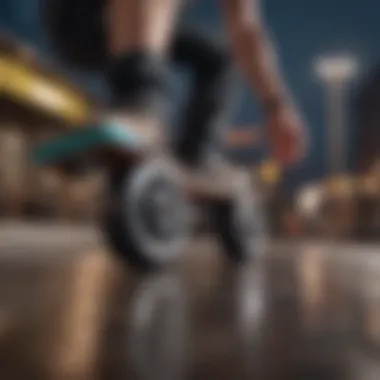
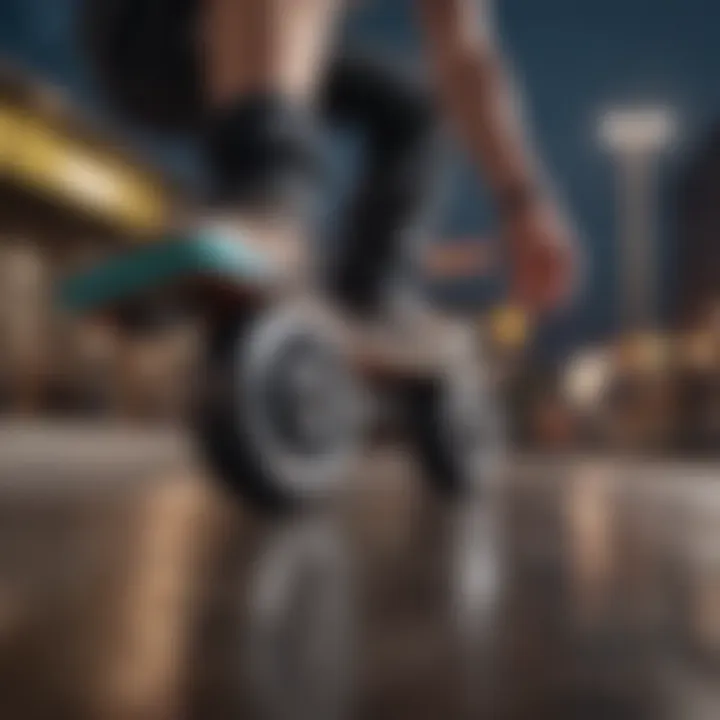
Another frequent error is attempting to powerslide at high speeds without proper technique. This often leads to wipeouts rather than smooth slides. Stick to a manageable speed until you feel more comfortable with the maneuver.
Finally, dismissing the importance of body positioning can lead to failure. Ensure your feet are aligned properly on the board and your knees are bent. Focus on the movements dictated above to reduce mistakes. Recognizing these common pitfalls is the first step in refining your skills.
"To truly master the powerslide, one must combine technique with confidence and practice consistently."
In summary, executing the powerslide requires a blend of preparation, specific movements, and awareness of common mistakes. Engaging in regular practice while correcting errors will enhance your ability, ultimately leading to a more enjoyable skateboarding experience.
Powerslide Applications Across Styles
Understanding the powerslide is essential for any skateboarder looking to enhance their skills across various styles of skating. The powerslide is not just a maneuver; it serves as a critical technique that influences control, speed, and overall performance. By mastering this skill, skateboarders can adapt to different terrains and setups, optimizing their ride and heart of each unique skating discipline. For extreme sports enthusiasts, delineating the applications of the powerslide helps to unlock the full potential of their craft.
Street Skating
In the realm of street skating, the powerslide plays a pivotal role in both style and functionality. Street skaters often navigate tight spaces and crowded environments. Engaging in a powerslide allows for sharp turns and quick stops, which are crucial for avoiding obstacles or preparing for tricks. For instance, during a run down a set of stairs or around tight corners, employing a powerslide creates a fluid transition, maintaining speed while avoiding sudden conditions.
Furthermore, the aesthetic aspect of powersliding can enhance the visual appeal of a skateboarder’s performance. The ability to slide smoothly into a trick or a grind accentuates style points that are key in the street skating community.
Vert Skating
When it comes to vert skating, the powerslide assumes a different but equally important role. In vert setups, maintaining speed and control during descent and ascent is vital. A properly executed powerslide can help a skater adjust their trajectory effectively after a trick goes awry. This maneuver can also be part of a transition from descending to climbing, allowing a smooth re-entry into the vertical structure.
Moreover, in competitions, the ability to perform a powerslide on a ramp or half-pipe can add versatility to a skater’s repertoire. It serves as a transitional technique that can set up for more advanced aerial tricks, showcasing both skill and creativity to judges.
Downhill Skating
In downhill skating, the powerslide is chiefly concerned with safety and control. At high speeds, managing one's course becomes critical. A well-timed powerslide is often a lifesaver for skaters. It allows for deceleration and helps to avoid hazardous elements on the course, including debris or sharp turns.
Additionally, downhilling employs various styles of powersliding, such as the heel-side or toe-side, each suitable for particular conditions. Mastering these different styles can significantly enhance a skateboarder's ability to adapt and perform safely.
The Role of Equipment in Powersliding
The ability to execute a powerslide effectively relies heavily on the equipment used by skateboarders. While technique plays a crucial role, the right tools can significantly enhance performance and safety. This section explores important elements of skateboard construction, component options, and protective gear, bringing clarity to how equipment influences the execution of a powerslide.
Skateboard Design
Skateboard design is fundamental to mastering the powerslide. The board's shape, size, and materials determine how it reacts during tricks. A wider board can provide stability, which is crucial during a powerslide. Conversely, a narrower board enhances agility, allowing for quicker adaptability. Most skateboards feature a concave design, which aids in foot placement, facilitating better control over movements. Additionally, the construction materials—such as maple or bamboo—affect rigidity and response time. A board’s flex can either absorb shocks or make it less stable during high-speed slides, warranting careful consideration based on the skater’s style.
Wheels and Bearings
Wheels and bearings are pivotal in powersliding, influencing both speed and friction. The durometer, or hardness, of wheels impacts slide capability. Softer wheels are typically better for grip and rolling over rough surfaces, while harder wheels allow for easier slides but may lose traction on uneven terrain. When selecting wheels, one must balance these aspects according to the skating environment. Bearings, which determine wheel spin efficiency, also play a role. High-quality bearings like those from Bones or Mini Logo can enhance speed and improve the length of slides. An adequately maintained wheel and bearing setup allows for smoother transitions during powerslides.
Protective Gear
Safety cannot be overlooked when engaging in powersliding. Proper protective gear minimizes risks associated with falls and other accidents. Essential items include helmets, wrist guards, knee pads, and elbow pads. A helmet is non-negotiable, offering protection against head trauma. Wrist guards assist in preventing fractures or sprains from falling. Knee and elbow pads provide cushioning and support during impacts. By investing in quality protective gear, skateboarders can focus on refining their powerslide technique without the constant worry of injuries.
"Proper equipment not only aids in performance but also in safety, allowing skateboarders to push their limits with confidence."
Ultimately, understanding the role of equipment in powersliding is vital for both beginner and seasoned skaters. Continuous assessment of skateboard components, bearings, and safety gear ensures effective practice of powersliding techniques while promoting a safe and engaging experience.
Safety Considerations
In skateboarding, safety is a critical aspect that should never be overlooked. This article's focus on the powerslide technique necessitates a thorough understanding of the safety considerations involved. Mastering a powerslide can enhance control and fluidity in movement, but it also presents risks that must be managed.
The powerslide is a high-adrenaline maneuver that can lead to falls and potential injuries, especially for beginners. Understanding the environment, one's skill level, and the adequacy of equipment plays a significant role in minimizing these risks. Comprehensive safety practices ensure that skateboarders can enjoy the thrill of the ride while reducing exposure to potential dangers.
Risk Assessment
Assessing the risks associated with powersliding is crucial for both novice and seasoned skateboarders. Factors to consider include the skating surface, speed, and the surrounding environment. Powerslides executed on smooth surfaces typically yield better control compared to rough terrain, where the risk of losing balance increases.
Key aspects to evaluate might include:
- Skating Surface: Is it even and free of debris?
- Environment: Are there obstacles nearby that could impede movement?
- Speed Control: Can you manage your speed to maintain balance while executing the powerslide?
Identifying and mitigating these risks allows skateboarders to make informed decisions about when and where to perform their stunts. Staying aware of these elements enhances safety significantly.
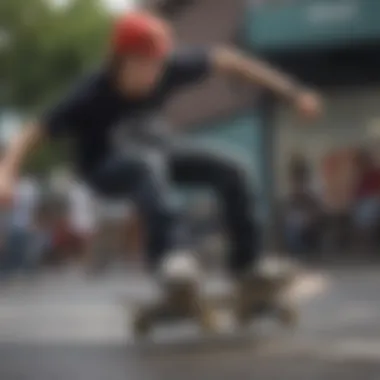
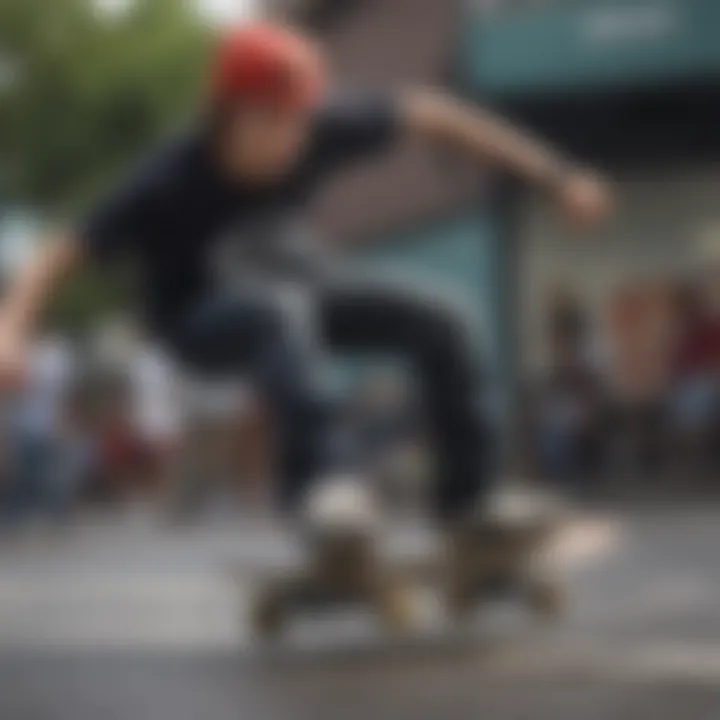
Injury Prevention Techniques
Injuries can often be avoided with proper preparation and techniques. To protect oneself while performing powerslides, there are several strategies to implement:
- Wear Protective Gear: Always don a helmet, knee pads, elbow pads, and wrist guards. This gear minimizes the risk of serious injury in case of a fall.
- Warm-Up Properly: Basic stretching and warming up enhance flexibility and reduce muscle tension, which is essential for balance during maneuvers like the powerslide.
- Practice in Safe Areas: Initially practicing in controlled environments, such as skate parks, can provide a safer platform to refine the technique.
- Gradual Learning Curve: Start with slower speeds and basic slides before progressing to more advanced maneuvers. This progressive approach builds confidence and skill.
"Safety must never be an afterthought in skateboarding, especially when engaging in technical moves like the powerslide."
In summary, well-planned safety considerations form the foundation of a successful skateboarding experience. By actively assessing risks and adopting injury prevention measures, skateboarders can enjoy their practice without unnecessary hazards.
Cultural Impact of the Powerslide
The powerslide, a maneuver often associated with skill and flair on the skateboarding scene, carries significant weight within skate culture. Understanding its cultural impact allows one to appreciate not only the technical prowess involved but also the broader societal implications that accompany this technique. The powerslide is more than just a way to prevent speed build-up or navigate tight corners; it has become a symbol of rebellion, creativity, and collaboration among skaters.
Representation in Media
The representation of the powerslide in media has played a crucial role in popularizing skateboarding. Films, documentaries, and social media platforms showcase this technique, elevating it to a level of artistry. Movies, such as Lords of Dogtown, depict the raw energy of the skateboarding community, highlighting specific scenes that feature impressive powerslides. This kind of visual storytelling resonates deeply, inspiring aspiring skaters to emulate the style and essence of their heroes.
Social media channels, especially Instagram and TikTok, now serve as platforms where skaters can share their prowess and creativity. Skateboarding influencers often showcase their powerslide techniques, sharing tips or innovative styles. This visibility cultivates a sense of aspiration and community among skaters worldwide. Importantly, it fosters an environment where creativity flourishes, as skaters adapt the powerslide to their unique styles.
"The powerslide represents a fusion of control and chaos, an essential aspect of skate culture, showcased brilliantly in both film and online media."
Influence on Skateboarding Community
The powerslide also influences the skateboarding community in several notable ways. As a cornerstone technique, it forms a connection among skaters, irrespective of their skill level. Learning and mastering this maneuver prompts collaboration and shared experiences—beginner skaters often seek guidance from seasoned skateboarders, leading to mentorship dynamics that enrich the culture.
Furthermore, skate parks frequently incorporate elements that cater specifically to powersliding, fostering an environment where this technique becomes a standard part of training and performance. Such facilities encourage skaters to push the limits of their creativity and technical skill, thus reinforcing the notion of the powerslide as essential to skateboarding.
Key points regarding the powerslide's cultural influence include:
- Skill Development: The powerslide is often a gateway move for beginners, solidifying their foundation in skateboarding.
- Camaraderie: Skaters share tips and techniques, fostering community connections.
- Innovative Expression: The powerslide allows for personalization and creativity, enabling skaters to showcase their unique style.
- Media Representation: Enhanced visibility through various media that elevates skateboarding's status.
Improving Your Powerslide Technique
Improving your powerslide technique can profoundly affect your overall skateboard performance. The powerslide is not merely a movement but a strategic maneuver that enhances control and precision during rides. Whether navigating tight corners or reducing speed, mastering this technique will elevate your skating experience. Understanding how to refine it requires dedicated practice and awareness of various drills and feedback mechanisms.
Practice Drills
Drills are essential to perfect the powerslide and establish muscle memory. Effective practice methods include:
- The Slow Slide: Begin at low speeds to focus on body positioning and weight distribution. Gradually introduce speed as comfort increases.
- The 180 Pivot: Work on combining a 180-degree turn with a powerslide. This helps in understanding how to shift weight while maintaining balance.
- The Straight Line Slide: Slide in a straight line to get familiar with position and handle how wheels respond to slight weight shifts.
- Gradual Stops: Practice stopping in a controlled manner using powerslides. This approach helps understand when to initiate the slide.
Engaging in these drills on various surfaces can provide different tactile experiences. Skateboarding in locations with differing terrain can also help simulate real-world conditions, thus enhancing adaptability.
Feedback and Adaptation
Receiving feedback is a critical part of improving your powerslide skills. Seeking out constructive criticism from more experienced skateboarders or coaches can yield valuable insights.
- Video Analysis: Recording your slides can reveal aspects you may not notice in real-time, such as body angles or foot placement.
- Peer Reviews: Asking friends or skate partners specifically what they observe while you practice can provide fresh perspectives.
- Self-Reflection: After each practice session, take a moment to assess what felt right and what didn’t. This reflection can help tailor future practice sessions.
- Adapt to Feedback: Once you understand the areas needing improvement, adapt your practice accordingly. Modify drills or try new techniques to incorporate feedback, fostering continuous growth in your skills.
Improvement is an ongoing process, and being receptive to change can lead to substantial gains in your powerslide technique.
Finale
The conclusion section ties the entire discussion on the powerslide technique together. This article aimed to dissect the mechanics and applications of the powerslide, showcasing its significance in skateboarding culture and performance. Understanding the powerslide is crucial for skaters of all levels. It provides foundational skills that enhance overall control and maneuverability on the board. By mastering the powerslide, skateboarders not only increase their own safety—reducing the risk of falls—but also elevate their style and confidence while riding.
Summarizing Key Takeaways
In summary, the powerslide serves several key purposes in the realm of skateboarding:
- Control: It aids in deceleration and cornering, allowing skaters to navigate tight spots efficiently.
- Style: The powerslide is a visually impressive maneuver that adds flair to a rider’s repertoire. It can be performed in various styles, from street skating to downhill racing.
- Safety: Developers good habits in balancing and weight distribution, thereby minimizing the risk of injuries.
- Skill Development: It enhances overall skating skills, making it easier to learn advanced tricks and techniques.
These takeaways highlight how the powerslide is not merely a technique but a vital aspect of skateboarding that contributes to the skater's performance and enjoyment.
Looking Ahead: The Future of Powerslides in Skateboarding
The future of the powerslide within skateboarding appears promising. As technology advances, skateboard design may evolve, likely influencing the execution and techniques associated with the powerslide. Skateboards like the Loaded Boards Icarus and Landyachtz Dinghy are examples of boards allowing smoother slides due to enhanced materials and construction techniques.
Moreover, as more skaters become aware of the powerslide's benefits, its popularity within different styles will likely increase. Emerging skateboarding communities could also drive innovation and adaptation of this technique. The incorporation of new digital platforms for tutorials, such as those found on Reddit and Facebook, provides skaters a chance to learn and share their expertise continually.
In gist, understanding and mastering the powerslide will continue to be essential for skateboarders, marrying tradition with innovation in the thrilling landscape of skating.







